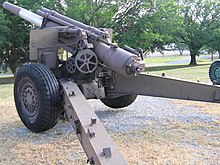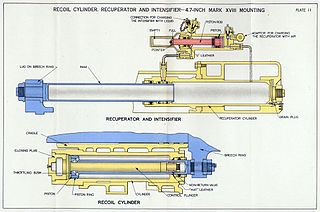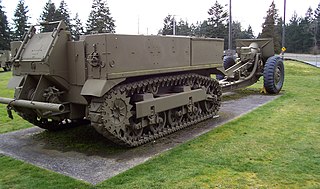
The 105 mm Howitzer Motor Carriage M7 was an American self-propelled artillery vehicle produced during World War II. It was given the official service name 105 mm Self Propelled Gun, Priest by the British Army, due to the pulpit-like machine gun ring, and following on from the Bishop and the contemporary Deacon self-propelled guns.

The 90–mm Gun M1/M2/M3 is an American heavy anti-aircraft and anti-tank gun, playing a role similar to the German 8.8cm Flak 18. It had a 3.5 in (90 mm) diameter bore, and a 15 ft (4.6 m) barrel, giving it a 50 caliber length. It was capable of firing a 3.5 in × 23.6 in shell 62,474 ft (19,042 m) horizontally, or a maximum altitude of 43,500 ft (13,300 m), the M1 can pierce 9 inches (228.6mm) of armor at 1,000 yards with APFSDS ammunition.

The M10 tank destroyer was an American tank destroyer of World War II. After US entry into World War II and the formation of the Tank Destroyer Force, a suitable vehicle was needed to equip the new battalions. By November 1941, the Army requested a vehicle with a gun in a fully rotating turret after other interim models were criticized for being too poorly designed. The prototype of the M10 was conceived in early 1942, being delivered in April of that year. After appropriate changes to the hull and turret were made, the modified version was selected for production in June 1942 as the 3-inch Gun Motor Carriage M10. It mounted a 3-inch Gun M7 in a rotating turret on a modified M4A2 Sherman tank chassis. An alternate model, the M10A1, which used the chassis of an M4A3 Sherman tank, was also produced. Production of the two models ran from September 1942 to December 1943 and October 1942 to November 1943, respectively.
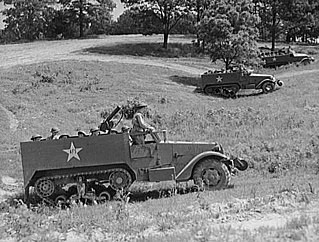
The M3 half-track was an American armored personnel carrier half-track widely used by the Allies during World War II and in the Cold War. Derived from the M2 half-track car, the M3 was extensively produced, with about 15,000 standard M3s and more than 38,000 variant units manufactured.

The M115 203 mm howitzer, also known as the M115 8 inch howitzer, was a towed howitzer developed and used by the United States Army.

The 105 mm M101A1 howitzer was an artillery piece developed and used by the United States. It was the standard U.S. light field howitzer in World War II and saw action in both the European and Pacific theaters. Entering production in 1941, it quickly gained a reputation for accuracy and a powerful punch. The M101A1 fired 105 mm high explosive (HE) semi-fixed ammunition and had a range of 12,330 yards (11,270 m), making it suitable for supporting infantry.
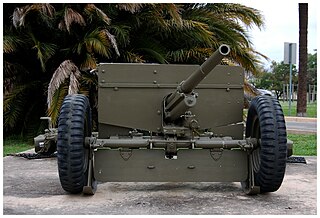
The 37 mm Gun M3 is the first dedicated anti-tank gun fielded by United States forces in numbers. Introduced in 1940, it became the standard anti-tank gun of the U.S. infantry with its size enabling it to be pulled by a jeep. However, the continuing improvement of German tanks quickly rendered the 37 mm ineffective and, by 1943, it was being gradually replaced in the European and Mediterranean theaters by the more powerful British-developed 57 mm Gun M1. In the Pacific, where the Japanese tank threat was less significant, the M3 remained in service until the end of the war.

The 3-inch gun M1918 was a United States 3-inch anti-aircraft gun that entered service in 1918 and served until it was largely superseded by the 3-inch anti-aircraft gun M3 in 1930, though the M1918 remained with some National Guard units until early in World War II. The M3 was subsequently replaced by the M1 90mm AA gun early in World War II, primarily during 1942. The M3 3" gun was later adapted for the anti-tank role, serving as the main armament of the M10 tank destroyer during World War II.
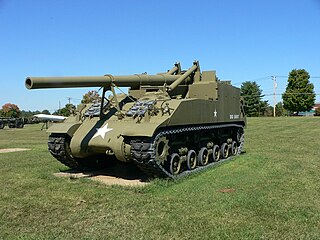
The 155 mm Gun Motor Carriage M40 was an American self-propelled artillery vehicle built on a widened and lengthened Medium Tank M4A3 chassis, but with a Continental engine and with HVSS, which was introduced at the end of the Second World War.

The 76 mm gun M1 was an American World War II–era tank gun developed by the U.S Ordnance Department in 1942 to supplement the 75 mm gun on the basic Medium tank M4. It was also used to arm the M18 Hellcat tank destroyer.

The 105 mm Howitzer M3 was a U.S. light howitzer designed for use by airborne troops. The gun utilized the barrel of the 105 mm Howitzer M2, shortened and fitted to a slightly modified split trail carriage of the 75 mm pack howitzer.

The 155 mm Gun M1 was a 155 millimeter caliber field gun developed and used by the United States military. Nicknamed "Long Tom", it was produced in M1 and M2 variants, later known as the M59. Developed to replace the Canon de 155mm GPF, the gun was deployed as a heavy field weapon during World War II and the Korean War, and also classed as secondary armament for seacoast defense. The gun could fire a 45.36 kg (100 lb) shell to a maximum range of 22 km (13.7 mi), with an estimated accuracy life of 1,500 rounds.

The 3 inch Gun M5 was an anti-tank gun developed in the United States during World War II. The gun combined a 3-inch (76.2 mm) barrel of the anti-aircraft gun T9 and elements of the 105 mm howitzer M2. The M5 was issued exclusively to the US Army tank destroyer battalions starting in 1943. It saw combat in the Italian Campaign and in the Northwest Europe campaign.

The 240 mm Howitzer M1, popularly nicknamed the "Black Dragon", was a towed howitzer used by the United States Army. The 240 mm M1 was designed to replace the World War I era 240 mm Howitzer M1918 which was based on a 1911 French design and was outdated by World War II. The project to replace the M1918 began in 1941. The 240 mm howitzer was the most powerful weapon deployed by US field artillery units during World War II, able to fire a 360 lb (160 kg) high explosive projectile 25,225 yards (23 km). It was the largest field piece used by the US Army during the war except for naval ordnance adapted into railway guns. The weapon addressed the requirement for super heavy field artillery capable of attacking heavily reinforced targets like those likely to be found along the Siegfried Line.

The 16 inch Gun M1919 (406 mm) was a large coastal artillery piece installed to defend the United States' major seaports between 1920 and 1946. It was operated by the United States Army Coast Artillery Corps. Only a small number were produced and only seven were mounted; in 1922 and 1940 the US Navy surplussed a number of their own 16-inch/50 guns, which were mated to modified M1919 carriages and filled the need for additional weapons.

The 8-inch Gun M1 was a 203 mm towed heavy gun developed in the United States. At 32,584 m (35,635 yd), it had the longest range of any US Army field artillery weapon in World War II. It was also used in small numbers by the British Army.

The 75mm Pack Howitzer M1 was an artillery piece used by the United States. It was designed in the 1920s to meet a need for a howitzer that could be moved across difficult terrain. The gun and carriage was designed so that it could be broken down into several pieces to be carried by pack animals. The gun saw combat in World War II with the United States Army, with US Marine Corps, and was also supplied to foreign forces.

The T48 57 mm Gun Motor Carriage was a self-propelled anti-tank gun produced by the Diamond T company in 1943 for the United States. The design incorporated a 57 mm gun M1, a US production of the British Ordnance QF 6 pounder, mounted on an M3 Half-track.

The T19 Howitzer Motor Carriage (HMC), was a 105 mm (4.1 in) howitzer mounted on a M3 Half-track chassis. It saw service during World War II with the U.S. Army. Its secondary armament consisted of an air-cooled .50 in (13 mm) M2 machine gun for local defense. It was produced by Diamond T between January 1942 and April 1942.
